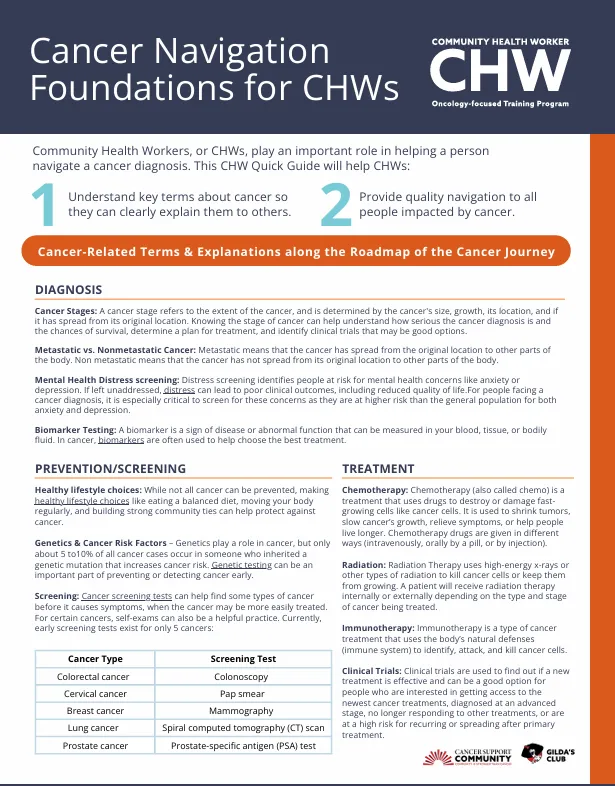Quick Guide - Cancer Navigation Foundations for CHWs
Table of Contents

Cancer-related Terms & Explanations Along the Cancer Journey
Diagnosis
Cancer Stages - A cancer stage refers to the extent of the cancer, and is determined by the cancer's size, growth, its location, and if it has spread from its original location. Knowing the stage of cancer can help understand how serious the cancer diagnosis is and the chances of survival, determine a plan for treatment, and identify clinical trials that may be good options.
Metastatic vs. Nonmetastatic Cancer - Metastatic means that the cancer has spread from the original location to other parts of the body. Nonmetastatic means that the cancer has not spread from its original location to other parts of the body.
Mental Health Distress screening - Distress screening identifies people at risk for mental health concerns like anxiety or depression. If left unaddressed, distress can lead to poor clinical outcomes, including reduced quality of life. For people facing a cancer diagnosis, it is especially critical to screen for these concerns as they are at higher risk than the general population for both anxiety and depression.
Biomarker Testing - A biomarker is a sign of disease or abnormal function that can be measured in your blood, tissue, or bodily fluid. In cancer, biomarkers are often used to help choose the best treatment.
Prevention/Screening
Healthy lifestyle choices - While not all cancer can be prevented, making healthy lifestyle choices like eating a balanced diet, moving your body regularly, and building strong community ties can help protect against cancer.
Genetics & cancer risk factors - Genetics play a role in cancer, but only about 5%-10% of all cancer cases occur in someone who inherited a genetic mutation that increases cancer risk. Genetic testing can be an important part of preventing or detecting cancer early.
Screening - Cancer screening tests can help find some types of cancer before it causes symptoms, when the cancer may be more easily treated. For certain cancers, self-exams can also be a helpful practice. Currently, early screening tests exist for only 5 cancers. See cancer type and screening tests below:
- colorectal cancer - colonoscopy
- cervical cancer - Pap smear
- breast cancer - mammography
- lung cancer - spiral computed tomography (CT) scan
- prostate cancer - prostate-specific antigen (PSA) test

Treatment Options
Chemotherapy (also called chemo) is a treatment that uses drugs to destroy or damage fast growing cells like cancer cells. It is used to shrink tumors, slow cancer’s growth, relieve symptoms, or help people live longer. Chemotherapy drugs are given in different ways (intravenously, orally by a pill or by injection).
Radiation therapy uses high-energy x-rays or other types of radiation to kill cancer cells or keep them from growing. A patient will receive radiation therapy internally or externally depending on the type and stage of cancer being treated.
Immunotherapy is a type of cancer treatment that uses the body’s natural defenses (immune system) to identify, attack, and kill cancer cells.
Clinical trials are used to find out if a new treatment is effective and can be a good option for people who are interested in getting access to the newest cancer treatments, diagnosed at an advanced stage, no longer responding to other treatments, or are at a high risk for recurring or spreading after primary treatment.
Survivorship
The word survivorship means different things to different people. The National Coalition for Cancer Survivorship defines a cancer survivor as someone who lives with, through and beyond cancer. Other definitions focus on the time after active treatment through the rest of one’s life. Survivors’ focus shifts from treatment to follow-up care.
Recurrence
Recurrence means the return of cancer. The fear of cancer coming back is normal. Encourage folks to stay in communication with their healthcare team and report any new signs or symptoms lasting more than 2 weeks.
Key Support Team
A patient’s healthcare team can include doctors, nurses, social workers, and other professionals. This is often called “multidisciplinary care”. Working with a multidisciplinary care team is important because each professional will bring specialized knowledge and a different set of skills. A diverse skill set is helpful when deciding how to treat cancer and manage its side effects.
A cancer patient will have many members on their cancer care team, and the number of members on the care team may vary at different points in the cancer journey. These members may include:
- Oncologist
- Radiation oncologist
- Surgical oncologist
- Oncology nurse
- Oncology pharmacist
- Oncology dietitian/nutritionist
- Nutritionist/dietitian
- Exercise specialist
- Nurse navigator
- Primary care physician
- Physical & occupational therapists
- Mental health providers
- Integrative health specialists (massage, acupuncture)
- Lymphedema specialist
- Community health workers
- Financial navigator
- Social worker
- Faith-based leaders
- Caregivers
- Support groups
- Family and friends
External Resources
Explore a list of organizations that provide information, support, or other services for people impacted by cancer.
How CHWs Can Help
Here are 3 things CHWs can do to better support people impacted by cancer:
- Educate patients with information that inspires hope. For example, encourage a patient to get their annual screening by sharing the % of people who receive a diagnosis from a screening, the % of patients that recover from a diagnosis, and/or the % of patients that experience a recurrence.
- Encourage patients to prepare for and attend their appointments, both during and after treatment. The 2-3 weeks leading up to the appointment is an important time for patients to plan the logistics of attending like transportation, and supporting their mental health.
- Empower patients with resources to make decisions about their care. This includes information on improving communication with healthcare teams, making treatment decisions, and navigating the cost of cancer.
Would you like a print copy of these educational materials?
We can mail our Frankly Speaking About Cancer pieces to you. Shipping is free for up to 20 pounds.
